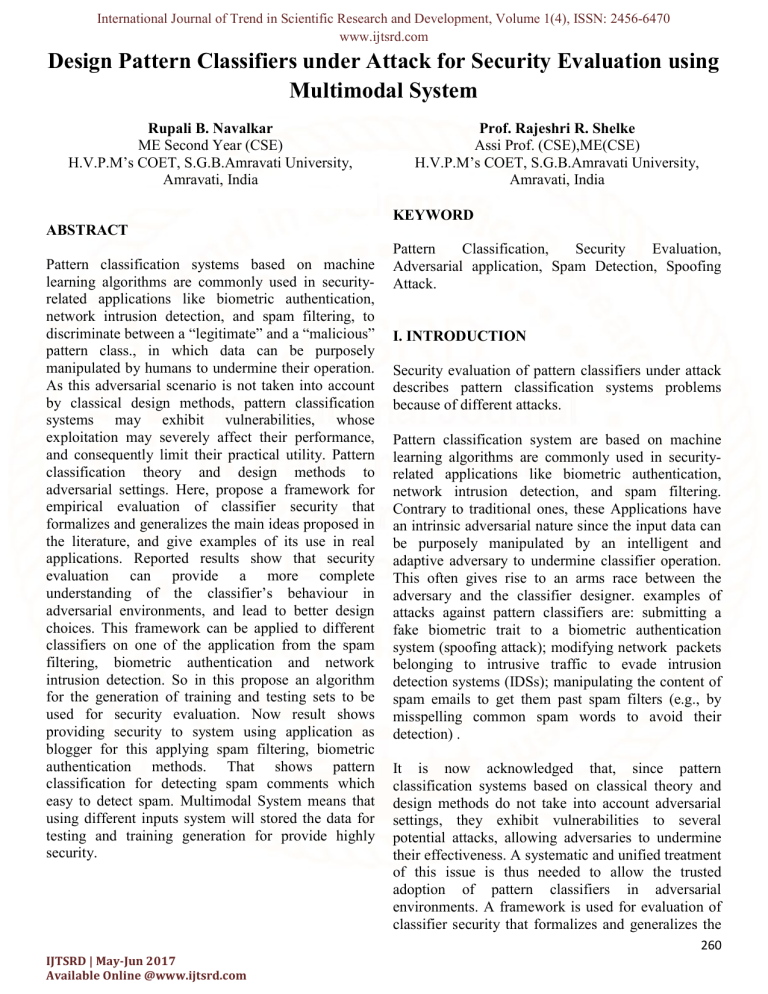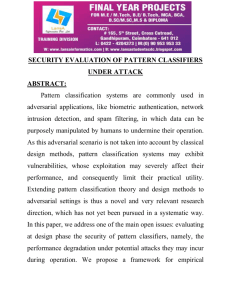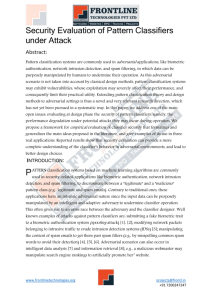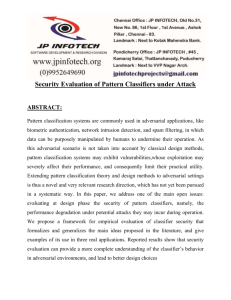
International Journal of Trend in Scientific Research and Development, Volume 1(4), ISSN: 2456-6470
www.ijtsrd.com
Design Pattern Classifiers under Attack for Security Evaluation using
Multimodal System
Rupali B. Navalkar
ME Second Year (CSE)
H.V.P.M’s COET, S.G.B.Amravati University,
Amravati, India
ABSTRACT
Pattern classification systems based on machine
learning algorithms are commonly used in securityrelated applications like biometric authentication,
network intrusion detection, and spam filtering, to
discriminate between a “legitimate” and a “malicious”
pattern class., in which data can be purposely
manipulated by humans to undermine their operation.
As this adversarial scenario is not taken into account
by classical design methods, pattern classification
systems may exhibit vulnerabilities, whose
exploitation may severely affect their performance,
and consequently limit their practical utility. Pattern
classification theory and design methods to
adversarial settings. Here, propose a framework for
empirical evaluation of classifier security that
formalizes and generalizes the main ideas proposed in
the literature, and give examples of its use in real
applications. Reported results show that security
evaluation can provide a more complete
understanding of the classifier’s behaviour in
adversarial environments, and lead to better design
choices. This framework can be applied to different
classifiers on one of the application from the spam
filtering, biometric authentication and network
intrusion detection. So in this propose an algorithm
for the generation of training and testing sets to be
used for security evaluation. Now result shows
providing security to system using application as
blogger for this applying spam filtering, biometric
authentication methods. That shows pattern
classification for detecting spam comments which
easy to detect spam. Multimodal System means that
using different inputs system will stored the data for
testing and training generation for provide highly
security.
Prof. Rajeshri R. Shelke
Assi Prof. (CSE),ME(CSE)
H.V.P.M’s COET, S.G.B.Amravati University,
Amravati, India
KEYWORD
Pattern
Classification,
Security
Evaluation,
Adversarial application, Spam Detection, Spoofing
Attack.
I. INTRODUCTION
Security evaluation of pattern classifiers under attack
describes pattern classification systems problems
because of different attacks.
Pattern classification system are based on machine
learning algorithms are commonly used in securityrelated applications like biometric authentication,
network intrusion detection, and spam filtering.
Contrary to traditional ones, these Applications have
an intrinsic adversarial nature since the input data can
be purposely manipulated by an intelligent and
adaptive adversary to undermine classifier operation.
This often gives rise to an arms race between the
adversary and the classifier designer. examples of
attacks against pattern classifiers are: submitting a
fake biometric trait to a biometric authentication
system (spoofing attack); modifying network packets
belonging to intrusive traffic to evade intrusion
detection systems (IDSs); manipulating the content of
spam emails to get them past spam filters (e.g., by
misspelling common spam words to avoid their
detection) .
It is now acknowledged that, since pattern
classification systems based on classical theory and
design methods do not take into account adversarial
settings, they exhibit vulnerabilities to several
potential attacks, allowing adversaries to undermine
their effectiveness. A systematic and unified treatment
of this issue is thus needed to allow the trusted
adoption of pattern classifiers in adversarial
environments. A framework is used for evaluation of
classifier security that formalizes and generalizes the
260
IJTSRD | May-Jun 2017
Available Online @www.ijtsrd.com
International Journal of Trend in Scientific Research and Development, Volume 1(4), ISSN: 2456-6470
www.ijtsrd.com
training and testing datasets. Results show that
security evaluation can provide a more complete
understanding of the classifier’s behaviour in
adversarial environments, and lead to better design
choices. Adversarial machine learning is a research
field that lies at the intersection of machine learning
and computer security. In the previous sections, we
introduced the problem of pattern recognition and
adversarial classification.
In Design pattern classification under attack using a
framework for empirical evaluation of classifier
security that formalizes and generalizes the main
ideas proposed in the literature, and give examples of
its use in real applications. Reported results show that
security evaluation can provide a more complete
understanding of the classifier’s behavior in
adversarial environments, and lead to better design
choices. This framework can be applied to different
classifiers on one of the application from the spam
filtering, and network intrusion detection. Considering
Multimodal system is the security of account when
one of the modes is successfully spoofed. that the
proposed methodology to rank score fusion rules is
capable of providing correct ranking of score fusion
rules under spoof attack .Spoofing attacks where one
person or program purposely falsifying data and there
by gaining an illegitimate advantage. It discusses how
the classical design cycle of pattern classifiers should
be revised to take security into account.
Spoof attacks consist in submitting fake biometric
traits to biometric systems [2][4], and this is a major
threat in security.
The presence of an intelligent and adaptive adversary
makes the classification problem highly nonstationary[1], and makes it difficult to predict how
many and which kinds of attacks a classifier will be
subject to during operation, that is, how the data
distribution will change. In particular, the testing data
processed by the trained classifier can be affected by
both exploratory and causative attacks, while the
training data can only be affected by causative
attacks, In both cases, during operation, testing data
may follow a different distribution than that of
training data, when the classifier is under attack.
Therefore, security evaluation cannot be carried out
according to the classical paradigm of performance
evaluation [1][2][3].
Security problems often lead to a “reactive” arms race
between the adversary and the classifier designer [2].
At each step, the adversary analyzes the classifier
defences, and develops an attack strategy to overcome
them [1]. Many authors implicitly performed security
evaluation as a what-if analysis, based on empirical
simulation methods; they mainly focused on a specific
application, classifier and attack, their goal was either
to point out a previously unknown vulnerability, or to
evaluate security against a known attack.
A. Previous Review On Security Evaluation
II. LITERATURE REVIEW
In this review on previous work, Security Evaluation
of Pattern classification systems based on machine
learning algorithms are commonly used in securityrelated applications like biometric authentication,
network intrusion detection, and spam filtering, to
discriminate between a “legitimate” and a “malicious”
pattern class[1][2]. Pattern classification systems
based on classical theory and design methods do not
take into account adversarial settings. They exhibit
vulnerabilities to several potential attacks, allowing
adversaries to undermine their effectiveness [3].
Biometric systems have been found to be useful tools
for person identification and verification.
A biometric characteristic is any physiological of
behavioural trait of a person that can be used to
distinguish that person from other people [2][6].
Many authors implicitly performed security
evaluation as a what-if analysis, based on empirical
simulation methods; however, they mainly focused on
a specific application, classifier and attack, and
devised ad hoc security evaluation procedures based
on the exploitation of problem knowledge and
heuristic techniques. Their goal was either to point out
a previously unknown vulnerability, or to evaluate
security against a known attack.
III. PROPOSED WORK
In this proposed work we address issues above by
developing a framework for the empirical evaluation
of classifier security at design phase that extends the
model selection and performance evaluation steps of
the classical design cycle. We summarize previous
261
IJTSRD | May-Jun 2017
Available Online @www.ijtsrd.com
International Journal of Trend in Scientific Research and Development, Volume 1(4), ISSN: 2456-6470
www.ijtsrd.com
work, and point out three main ideas that emerge from
it. We then formalize and generalize them in our
framework.
To pursue security in the context of an arms race it
is not sufficient to react to observed attacks, but it
is also necessary to proactively anticipate the
adversary by predicting the most relevant,
potential attacks through a what-if analysis; this
allows one to develop suitable countermeasures
before the attack actually occurs, according to the
principle of security by design.
To provide practical guidelines for simulating
realistic attack scenarios, we define a general
model of the adversary, in terms of her goal,
knowledge, and capability, which encompass and
generalize models proposed in previous work.
Since the presence of carefully targeted attacks
may affect the distribution of training and testing
data separately, we propose a model of the data
distribution that can formally characterize this
behavior, and that allows us to take into account a
large number of potential attacks;
Also propose an pattern classifier for security
evaluation, which can naturally accommodate
application-specific and heuristic techniques for
simulating attacks.
Adversarial classification
Security modules
The definition of attack scenarios is ultimately an
application-specific issue, it is possible to give general
guidelines that can help the designer of a pattern
recognition system.
Pattern classification is the scientific discipline whose
goal is to classify the objects into a number of classes
or categories, depending on the type of application,
these objects may be any type of measurements,
images or signal waveforms that need to be classified.
In pattern classification, typically a set of patterns (the
raw data), whose class is unknown, is given. In
addition, proper actions can be taken based on the
outcome of the pattern classification. a classifier is
designed by training it on a set of patterns (samples or
feature vectors) whose true class is known referred
also as training set or design set, to find a
classification function.
A. Framework
In this work we create a new framework to provide
security to adversarial application. we address issues
developing a framework for the empirical evaluation
of classifier security also propose algorithm used for
security evaluation and generation of training and
testing sets. when user wants to enter into the system
first user log in into the system if user is a
authenticated person and he enter correct user id,
password and also correct pattern only then system
permit user to access the system. If enter pattern is
wrong then pattern manager manage or classify the
pattern and provide more security the user account.
And also provide account information to user. In the
proposed system pattern manager find out the pattern
of attack and provide security to user account before
attack is completed. We define a general models :1. Modules:
Attack Scenario and Model of the Adversary
Pattern Classification
Figure 1.1 shows the various stages followed for the
design of a pattern classification system. The first step
is to collect a pre-processed set of training samples.
The role of data pre-processing module is therefore to
segment the pattern of interest from the background,
remove noise and any other operation which will
contribute in defining a compact representation of the
pattern. Features are then extracted from each training
sample. In practice, a larger than necessary number of
feature candidates is generated and then the best of
them are adopted. The classifier, which is chosen
among different algorithms, is trained on appropriate
features. Finally, once the classifier has been designed
(trained), one can evaluate the performance of the
designed classifier.
262
IJTSRD | May-Jun 2017
Available Online @www.ijtsrd.com
International Journal of Trend in Scientific Research and Development, Volume 1(
1(4),
), ISSN: 2456-6470
www.ijtsrd.com
1.2. Objectives.
2. Our future work will be devoted to develop
techniques for simulating attacks for different
applications.
3. Prevents developing novel methods to assess
classifier security against these attacks.
4. The presence of an intelligent and adaptive
adversary makes the classification problem highly
non-stationary.
5. We also propose an algorithm for the generation
of training and testing sets to be used for security
evaluation, which can naturally accommodate
application-specific
specific and heuristic techniques for
simulating attacks.
B. System Architecture
The main goal is difficult to represent to escape the
design classifiers in the Adversarial Classification
Problems with the help of the framework. An artifice
for providing the security for classifier designe
designer is to
mask the data to the Adversary. In the case of Arms
Armsrace, it is not possible to recommend how many and
what type of attacks a classifier will incur during
operation, the classifier security should proactively
evaluate using a what-if
if analysis, by ssimulating
potential attack scenarios. The primary goal is to
formulate or model the adversary as the optimization
of an actual function. The effective simulation of
attack scenarios requires a formal model of the
adversary. In many cases, according to the knowledge
of classifier and capability of manipulation of data,
the adversary acts rationally to attain a goal of
security evaluation.
Spam
Figure 2. System Architecture
VI. SYSTEM DESIGN
It shows that how to intruder trying to penetrate
system using different source which try to harm
system or manipulate information which is not
detecting by system. To avoid this problems system
syste
using different applications that are set of algorithms
which detect unusual traffic and spamming. System
trying to provide security through applications that
intruder trying to attacks.
Below shows the intruder to legitimate system
diagram that easy to understand.
Our main goal is to provide a quantitative and
general-purpose
purpose basis for the application of the what
whatif analysis to classifier security evaluation, based on
the definition of potential attack scenarios. Our main
goal is to provide a quantitative and general
general-purpose
basis for the application of the what--if analysis to
classifier security evaluation, based on the defini
definition
of potential attack scenarios.
263
IJTSRD | May-Jun 2017
Available Online @www.ijtsrd.com
International Journal of Trend in Scientific Research and Development, Volume 1(
1(4),
), ISSN: 2456-6470
www.ijtsrd.com
system using blog for performing operation. Blogger
is a website that displays postings views, thoughts. A
person who keeps a web log(blog), An online diary, a
personal chronological log of thoughts published on a
web page, also called web log.
Spam filter
ter is a program that is a program that is used
to detect unsolicited and unwanted data. And prevent
this using blog in our blog users posts comments that
comments are detecting by admin.
Admin has to authority to check comments and using
the knowledge
dge he decides that comments will
approved or reject. Because of this it prevents our
system from vulnerabilities also
a
admin can guide to
users for comments that why this comments approved
or reject. Then admin and users both can add new post
on blog.
For security evaluation our system used IP address
concept it means when user post comments on blog
from their systems, it will stored their system IP
address from this IP address we can find malicious
users that will help in future.
VI. CONCLUSION
Figure 3.. Intruder to legitimate system
This is system diagram that shows are intruder trying
to penetrate to system and how to system detect this
using spamming, and unusual traffic. Us
Using attack
classifiers concept our system using spam filters and
biometric simulation methods to become strong
system.
V. Execution Details
This section presents the detailed information about
the classification techniques in data mining in order to
demonstrate the complete process. Firstly, after
starting the system shown to the user is as follows. In
our system a new concept added i.e. Multimodal
System. So this mean that using different inputs
system will stored the data for testing and training
generation
neration for provide highly security. User can sign
in using different inputs password that using
biometric simulation as password in that it choose
image as password in sign in using face and in sign in
it takes as password as basic password oon home page,
In this Paper our main contribution is a framework for
empirical security evaluation that formalizes and
generalizes ideas from previous work, and can be
applied to different classifiers, learning algorithms,
and classification tasks. It is grounded on a formal
f
model of the adversary, and on a model of data
distribution that can represent all the attacks
considered in previous work, provides a systematic
method for the generation of training and testing sets
that enables security evaluation; application-specific
techniques for attack simulation. This is a clear
advancement with respect to previous work, since
without a general framework most of the proposed
techniques could not be directly applied to other
problems. By combining multiple sources of
information,
on, these systems improve matching
performance, also the paper focused on innovative
security evaluation of pattern classifiers that deployed
in adversarial environments and analyzing on security
evaluation of pattern classification under attack
applying various methods.
264
IJTSRD | May-Jun 2017
Available Online @www.ijtsrd.com
International Journal of Trend in Scientific Research and Development, Volume 1(4), ISSN: 2456-6470
www.ijtsrd.com
ACNOWLEDGEMENT
I feel deeply indebted and thankful to all who opined
for technical knowhow and helped in collection of
data. also feel thankful to my guide shelke mam and
to all who directly and indirectly help me for
transactional information. A special thanks to my
family members for constant support and motivation.
REFERENCES
[1] Battista Biggio, Member, IEEE , Giorgio Fumera,
Member, IEEE, and Fabio Roli, Fellow, IEEE ,“
Security Evaluation of Pattern Classifiers under
Attack”,
IEEE
TRANSACTIONS
ON
KNOWLEDGE AND DATA ENGINEERING, VOL.
26, NO. 4, APRIL 2014.
[7] R.N. Rodrigues, L.L. Ling, and V. Govindaraju,
“Robustness of Multimodal Biometric Fusion
Methods against Spoof Attacks,” J. Visual Languages
and Computing, vol. 20, no. 3, pp. 169-179, 2009.
[8] R. R. Shelke ,Dr. V. M. Thakare, Dr. R . V.
Dharaskar,“Study of Data Mining Approach for
Mobile
Computing
Environment”,International
Journal on Computer Science and Engineering
(IJCSE) , ISSN : 0975-3397, Vol. 4, 12 Dec 2012
,pp.1920-1923
[9] Dr. Amitabh wahi, C.Prabhakaran “A Literature
Survey on Security Evaluation of Pattern Classifiers
under Attack” International Journal of Advance
Research in Computer Science and Management
Studies Volume 2, Issue 10, October 2014.
[2] S.P.Mohana Priya[1], S.Pothumani , “Identifying
Security Evaluation of Pattern Classifiers Under
attack”, International Journal of Innovative Research
in Science, Engineering and Technology (An ISO
3297: 2007 Certified Organization)Vol. 4, Issue 3,
March 2015.
[3] Kale Tai. , Prof. Bere S. S., “A Survey on:
Security Evaluation of Pattern Classifiers under
Attack”, International Journal of Innovative Research
in Computer and Communication Engineering (An
ISO 3297: 2007 Certified Organization) Vol. 3, Issue
11, November 2015.
[4]Yadigar Imamverdiyev , Lala Karimova, Vugar
Musayev , James Wayman, “ TESTING BIOMETRIC
SYSTEMS AGAINST SPOOFING ATTACKS” ,
The Second International Conference “Problems of
Cybernetics and Informatics” September 10-12, 2008,
Baku, Azerbaijan.
[5] Tanisha Aggarwal, Dr. ChanderKant Verma,
“Spoofing Technique for Fingerprint Biometric
system” ,IJSRD - International Journal for Scientific
Research & Development| Vol. 2, Issue 03, 2014 .
[6] Arun Ross and Anil K. Jain,”MULTIMODAL
BIOMETRICS: AN OVERVIEW” , Appeared in
Proc. of 12th European Signal Processing Conference
(EUSIPCO), (Vienna, Austria), pp. 1221-1224,
September 2004.
265
IJTSRD | May-Jun 2017
Available Online @www.ijtsrd.com




![[ ] ( )](http://s2.studylib.net/store/data/010785185_1-54d79703635cecfd30fdad38297c90bb-300x300.png)

